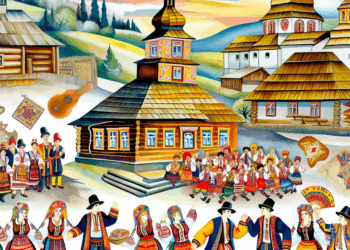Bukovina is a region rooted in the heart of Eastern Europe, which is renowned for its diverse culture, the result of the interaction of several nationalities and traditions. This region, located at the junction of Ukraine and Romania, has also been influenced by Jewish and Polish cultures, making its cultural landscape unique and multi-layered. In this article we will take a closer look at the traditions, folk costumes, crafts, festivals, music and folklore of Bukovina, reflecting all of its cultural mutual influences.
Historical Context
Bukovina (or Bukovina) is a historical region that was originally part of Galicia and was later part of Austria-Hungary, Romania, and the Soviet Union. These changes in the political map had an impact on the cultural life of the region, as evidenced by the diverse languages, rituals and traditions that have survived to this day.
Since the beginning of the 20th century, cities such as Chernivtsi, Kitsman, Storozhinets and others have adjoined Bukovyna, which contributed to the growth of multilingualism and multiculturalism. Chernivtsi, for example, concentrates numerous architectural monuments that are symbols of interaction between different peoples.
Traditions and Folk Costumes
Folk costumes of Bukovina are diverse, not only in terms of colours, but also in style, depending on the nationality. Traditional Bukovyna clothing reflects the rich history and artistic trends typical of different ethnic groups.
Ukrainian Clothing
Ukrainian folk costumes of Bukovina were made of linen and wool. Women wore long embroidered shirts with belts, and on their heads they wore kerchiefs or wreaths of flowers. Embroidery, representing complex patterns, was perceived as a special art and often symbolised protection from evil.
Romanian Clothing
Romanian costumes are also diverse. Men wore cottons and stockings, while women wore flowing skirts, often decorated with embroidery. An important element of Romanian costume is a cloak called a cerga. Mention of these costumes can be found in literature reflecting the customs of the Romanian people.
Handicrafts of Bukovina
The handicrafts of Bukovina occupy an important place in the life of the region. Craftsmen working in different fields create unique products, imbued with the spirit of local culture.
Pottery Art
The potential of crafts can be seen in famous pottery centres such as Kukol and Kitsman. Here, craftsmen make not only utilitarian ware, but also artistic pieces that emphasise the region’s heritage.
Weaving
Weaving is another important craft. The fabrics created in Bukovina are often exclusive due to the use of local motifs and bright colours. Craftswomen make belts, tablecloths and other household items that are decorated with traditional patterns.
Wood carving
Wood carving, especially in the Carpathians, also has its own traditions. Masters create unique objects – from crockery to jewellery. Ornamental carvings reflecting folk themes are an important part of the cultural heritage.
Holidays and Rites
Holidays in Bukovina are usually full of traditions that emphasise the diversity of cultures. Many festivals have agrarian roots and are linked to seasonal cycles.
Ivan Kupala
One of the most famous holidays is Ivan Kupala, celebrated on the night of 7 July. This holiday, which has both Ukrainian and Romanian roots, includes rituals related to fertility, fire and water. On the holiday, young people jump over the fire and look for the fern flower, assuring each other that it brings good luck and happiness.
Assumption of the Blessed Virgin Mary
This Orthodox date is also celebrated in Bukovina with a certain solemnity. Processions and open-air services are held in various towns, which is a basic element of the regional culture.
Fun at Dozhynki
Some localities hold Dozhynki, festivals celebrating the end of the harvest. These events include performances by artists, folklore dances and songs, and craft fairs.
Music and Folklore
The music of Bukovina is a reflection of its diverse culture, with elements of Ukrainian, Romanian and Jewish music intertwined.
Instruments
Traditional instruments include the bandura, cymbals, violins and sopilki. Each plays an important role in folk music. Collectives such as the Southern Gusliars perform both ancient and modern compositions, preserving the folk tradition.
Dances
Dances, such as the “Hutsulka” and the Romanian “Grechul”, are an integral part of holidays and family celebrations. They are often based on folk tunes and performed in traditional costumes.
Tales and Legends
The folklore of Bukovina is rich in tales and legends. One of the most famous legends is the story of the “Black Mountain”, the guardian of the forests and inhabitants, who protects them from misfortune. These stories are passed down from generation to generation and are the basis of local identity.
Influence of Different Cultures
The culture of Bukovina would not be complete without the influence of Jewish and Polish traditions. The Jewish community that has existed in the region for centuries has left a significant mark in architecture, music and cookery.
Jewish Culture
Chernivtsi, a renowned cultural centre, was home to many Jewish schools and theatres. The influence of Jewish music can be heard in local songs. Nearby rituals such as Hanukkah and Purim are also reflected in local festivals.
Polish Culture
Polish culture has influenced architecture and cookery. Traditional Polish dishes such as borscht and pierogi can be found in Bukovina, adding to the richness of the local cuisine.
Conclusion
The culture of Bukovina is a living and breathing canvas in which the threads of many nations are intertwined. Ukrainian, Romanian, Jewish and Polish traditions have created a unique richness that is a jewel both for the people of the region themselves and for all who wish to explore it. Community festivals, folk costumes and crafts continue to live and develop, preserving the memory of ancestors and emphasising the importance of the diversity of cultures. In this region, every day is a celebration, filled with the sounds of music, the colours of embroidery and the aromas of traditional dishes. All this makes Bukovina a place where cookery, art and folklore intertwine to create a truly unique cultural heritage.








